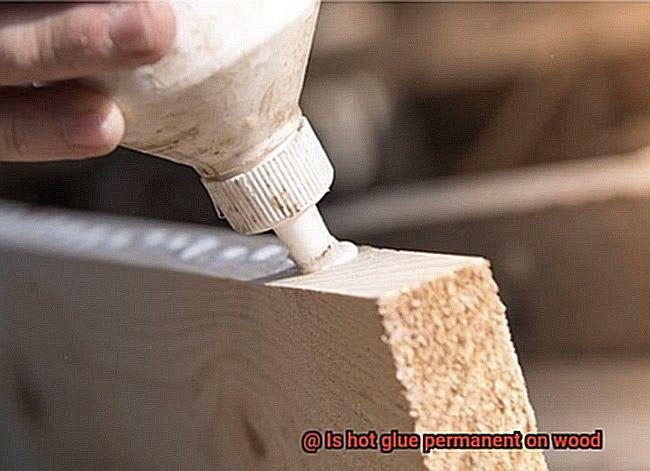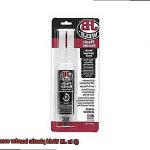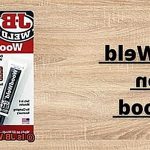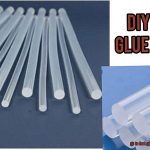Hot glue, the DIY darling of crafters and creators everywhere.
Its versatility and convenience make it a top choice for bonding materials, especially wood. But here’s the burning question: is hot glue really permanent on wood?
Whether you’re tackling a woodworking project or fixing a broken wooden item, knowing the staying power of this adhesive is key. So, let’s dive into the world of hot glue and its relationship with wood.
Grab your cup of coffee, get cozy, and let’s uncover the secrets of hot glue’s bond with wood.
What is Hot Glue?
Contents
- 1 What is Hot Glue?
- 2 Factors Affecting the Permanence of Hot Glue on Wood
- 3 Types of Wood and Their Impact on Hot Glue Bond Strength
- 4 Quality of Hot Glue and Its Effects on Bond Strength
- 5 Environmental Conditions That May Weaken the Bond
- 6 Is Hot Glue a Permanent Adhesive?
- 7 Alternatives to Hot Glue for Permanent Bonding on Wood
- 8 Conclusion

Hot glue, also known as hot melt adhesive, is a versatile and widely used adhesive that has become a staple in the crafting and DIY community. With its quick-drying properties and ability to bond various materials together, hot glue has become the go-to adhesive for a wide range of applications. In this blog post, we will explore the advantages and limitations of hot glue, its unique properties, and when it is best used.
Advantages of Hot Glue:
- Fast Setting Time: Hot glue offers a rapid setting time, allowing for immediate handling once applied. This eliminates the need for clamping or holding materials together while waiting for the adhesive to dry.
- Versatility: Hot glue is compatible with a wide range of materials, including wood, plastic, fabric, ceramics, glass, and metal. Whether you’re working on a woodworking project, creating intricate crafts, or repairing household items, hot glue can provide a reliable bond.
- Ease of Use: Using hot glue is simple and convenient. With a hot glue gun and glue sticks, you can easily insert the stick into the gun, wait for it to melt, and apply the adhesive to the desired surface. The gun’s trigger mechanism allows for precise control over the amount of glue dispensed.
- Good Bonding Strength on Porous Surfaces: Hot glue excels at bonding porous surfaces like wood. It penetrates into the material’s pores, creating a strong mechanical grip that holds even under moderate stress.
Limitations of Hot Glue:
- Limited Durability: While hot glue provides a strong bond on porous surfaces like wood, its durability may vary depending on the specific application and materials involved. It may not be suitable for load-bearing or high-stress applications where other types of adhesives, such as epoxy or construction adhesive, may be more appropriate.
- Sensitivity to Temperature and Moisture: Hot glue can be sensitive to extreme temperatures and moisture. Exposure to high heat can cause the glue to soften or lose its adhesion, while moisture can weaken the bond over time. It is important to consider the environmental conditions in which the bonded object will be exposed to when using hot glue.
Factors Affecting the Permanence of Hot Glue on Wood
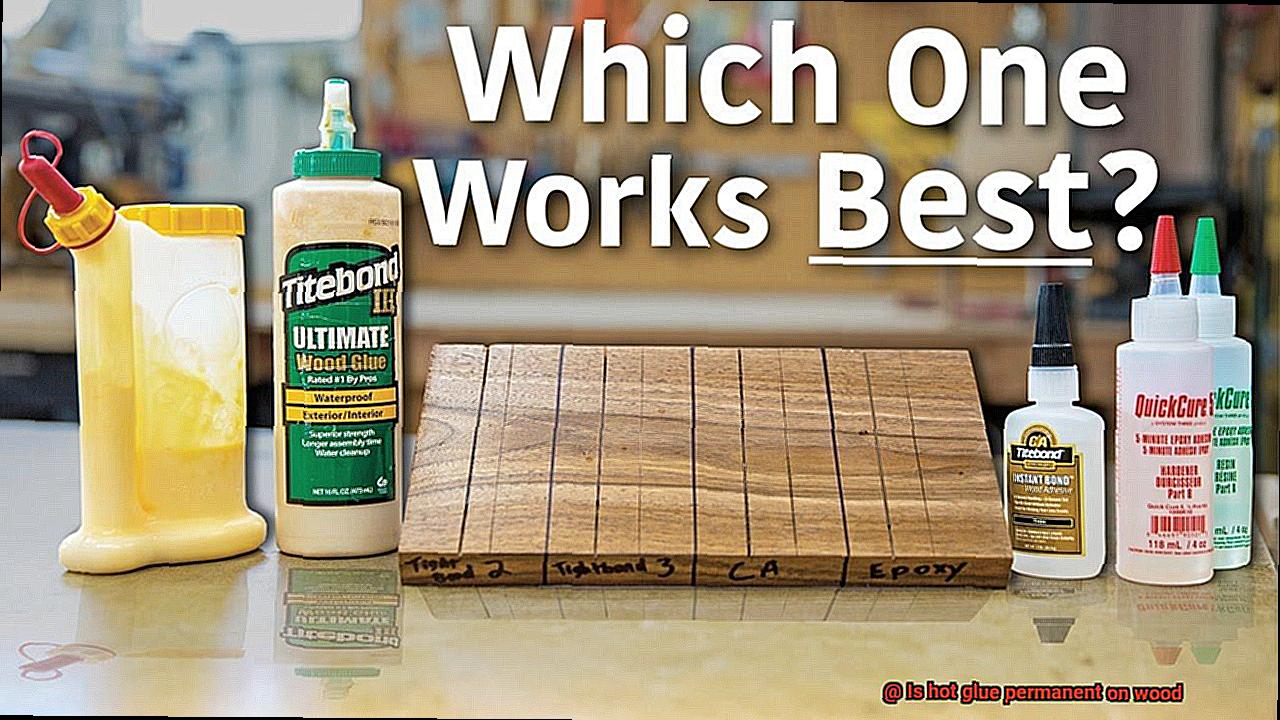
Hot glue, that magical adhesive that seems to bond everything in an instant, is a favorite among crafters and DIY enthusiasts. Its versatility and ease of use make it the go-to glue for various projects, especially when working with wood. But have you ever wondered what factors influence the permanence of hot glue on wood? Today, we delve into the secrets behind this superhero adhesive and uncover the key factors that determine its long-lasting hold on wood surfaces.
The Type of Hot Glue Matters:
Not all hot glues are created equal. Low-temperature glue may not provide a strong bond on wood, especially for heavy-duty applications. High-temperature or industrial-strength glues, on the other hand, offer a stronger and more permanent bond. So, be sure to choose the right type of hot glue for your specific woodworking project.
Temperature: Handle with Care:
Temperature plays a crucial role in achieving a strong bond. Applying hot glue at the recommended temperature range ensures optimal adhesion. Too low, and the glue won’t melt properly; too high, and it can damage the wood or become brittle, resulting in weaker bonding. So, pay attention to those temperature settings to ensure a lasting bond.
Surface Preparation is Key:
A clean surface is essential for hot glue to adhere effectively to wood. Remove any dust, grease, or contaminants that could hinder adhesion. Lightly sanding the wood creates a rough surface that allows the glue to grip better. Also, consider the porosity of the wood when choosing the appropriate hot glue – some glues work better on porous surfaces.
Wood Type: The Silent Player:
The type of wood you’re using can impact the permanence of hot glue. Hardwoods like oak or maple generally provide a better bonding surface due to their density and grain structure. Softwoods like pine or cedar may require special attention to ensure a strong bond. When selecting your hot glue, consider the wood type to maximize its effectiveness.
Mother Nature’s Influence:
Environmental conditions can affect the longevity of hot glue on wood. High humidity or exposure to moisture can weaken the bond over time, leading to failure. Extreme temperature fluctuations or direct sunlight can degrade the glue, compromising its adhesive properties. Choose a hot glue suitable for the intended environment or opt for waterproof or weather-resistant glues when needed.
Technique is Everything:
The application technique used can make or break the bond. Applying an even and sufficient amount of glue ensures proper coverage and bonding strength. Too much glue can result in messy and weak bonds, while too little may not create a strong enough hold. Follow the manufacturer’s instructions and apply the glue with precision for optimal results.
With these secrets unveiled, you now have a deeper understanding of what factors influence the permanence of hot glue on wood surfaces. By considering the type of glue, temperature, surface preparation, wood type, environmental conditions, and application technique, you can maximize the strength and longevity of your hot glue bonds.
Remember, while hot glue is a handy tool, it may not always be suitable for heavy-duty or load-bearing applications. In such cases, consider alternative adhesives or mechanical fasteners for a more permanent solution.
Types of Wood and Their Impact on Hot Glue Bond Strength
Understanding how the type of wood and other factors can impact the strength of the bond is crucial for successful projects. In this article, we will explore how the type of wood, its porosity, moisture content, and surface preparation can affect the bond strength of hot glue on wood. By delving into these aspects, you can achieve optimal results and create with confidence.
Softwoods vs. Hardwoods: Porosity as a Deciding Factor
Softwoods such as pine, cedar, and fir are popular choices due to their accessibility and workability. However, their porous nature poses challenges when it comes to bonding with hot glue. The open pores in softwoods tend to absorb the glue, resulting in a weaker bond. In contrast, hardwoods like oak, maple, and mahogany are denser, providing a more suitable surface for adhesion. The dense structure of hardwoods allows for a stronger and more long-lasting bond with hot glue.
Moisture Content: Dry Wood for Optimal Bonding
The moisture content of wood plays a significant role in the bond strength of hot glue. High moisture content can interfere with the adhesive properties, leading to weaker bonds. It is essential to ensure that the wood is dry before applying hot glue to achieve optimal bonding strength. Allowing the wood to acclimate to the desired humidity level is recommended before beginning any gluing process.
Surface Preparation: The Importance of Smoothness
The quality of the wood surface greatly affects bonding strength. Smooth and clean surfaces provide better contact between hot glue and wood, resulting in stronger bonds. Rough or uneven surfaces hinder proper adhesion and weaken the bond. To overcome this challenge, it is recommended to sand rough surfaces before applying hot glue. This process ensures a smooth and even bonding surface, maximizing the effectiveness of the adhesive.
Oily Woods: Rethinking Adhesive Solutions
Certain hardwoods contain natural oils or resins that can impede hot glue bonding. Woods like teak or rosewood may require additional measures to achieve a successful bond. Thoroughly cleaning the wood surface or using an adhesive specifically designed for oily woods can help overcome this challenge. Exploring alternative adhesives, such as epoxy or specialized woodworking glues, may be necessary for optimal results.
Hot Glue’s Durability: Understanding Limitations
While hot glue is known for its quick-drying and strong bond, it is not considered a permanent adhesive like epoxy or wood glue. Factors such as extreme temperatures, humidity fluctuations, and stress on the bond can weaken or break the glue over time. For projects that require long-term durability, it is advisable to use specialized woodworking adhesives specifically formulated for permanent bonds.
Quality of Hot Glue and Its Effects on Bond Strength
In this article, we’ll explore the various factors that influence the quality of hot glue and how they can impact the strength of the bond.
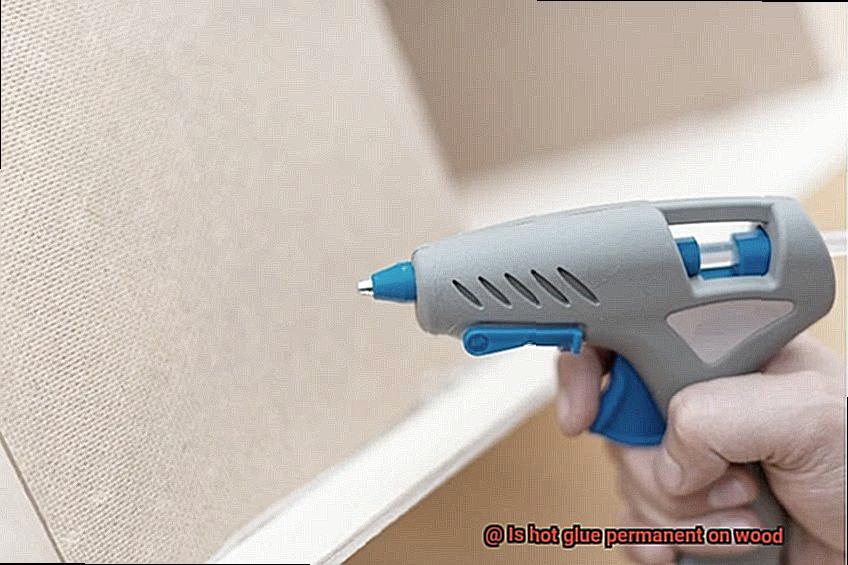
Firstly, let’s talk about temperature. The temperature at which hot glue melts and solidifies plays a crucial role in its quality. High-quality hot glue typically has a lower melting point, making it easier to work with and ensuring a strong bond. So, when selecting hot glue, look for one that melts easily and quickly.
Viscosity is another important factor to consider. The viscosity, or thickness, of the hot glue can greatly impact its bonding strength. A thicker hot glue tends to provide better bonding strength as it fills gaps and creates a more solid connection between the surfaces being glued. So, opt for a hot glue that has a thicker consistency for stronger bonds.
The adhesive properties of hot glue also play a significant role in its quality. Different hot glue sticks are designed for bonding specific materials such as wood, fabric, or plastic. So, make sure to choose a hot glue stick that is specifically designed for your project’s material. This will ensure better adhesion and a more durable bond.
Curing time is another factor that affects the bond strength of hot glue. It is crucial to allow enough time for the hot glue to fully harden and set properly. Rushing the curing process can result in weaker bonds that may not withstand stress or movement. So, be patient and give your hot glue enough time to cure before putting any strain on the bond.
External conditions also have an impact on the quality of hot glue and its bond strength. Extreme temperatures or high levels of moisture can weaken the bond or cause it to fail over time. So, make sure to avoid working in extreme conditions and provide proper ventilation during the curing process.
Another aspect to consider is the quality control of hot glue manufacturing. Some manufacturers may use inferior ingredients or processes, resulting in lower-quality hot glue that may not provide a strong bond. It is important to choose hot glue from reputable manufacturers with a track record of producing high-quality products.
Furthermore, the storage and shelf life of hot glue can also affect its quality. Hot glue that has been stored improperly or past its expiration date may have reduced bonding strength. Therefore, it is essential to store hot glue in a cool, dry place and check its expiration date before use.
Environmental Conditions That May Weaken the Bond
Hot glue is a beloved adhesive among both DIY enthusiasts and professionals for its versatility and quick bonding capabilities. When it comes to bonding wood, hot glue is often the adhesive of choice. However, it’s important to understand that environmental conditions can have a significant impact on the strength and longevity of hot glue bonds. In this article, we will delve into the various environmental factors that can weaken these bonds, shedding light on temperature extremes, humidity levels, water exposure, and the importance of selecting the right hot glue for specific conditions.
Temperature Extremes – The Heat is On:
Temperature extremes can be detrimental to hot glue bonds on wood. High temperatures exceeding the melting point of hot glue can cause it to soften or even melt, resulting in a weakened bond. Think about a wooden object bonded with hot glue left in a scorching car or exposed to direct sunlight; the excessive heat compromises the integrity of the bond. On the other hand, freezing temperatures make hot glue more rigid and brittle, increasing the risk of bond failure due to contraction and expansion of the wood caused by temperature changes.
Humidity – A Love-Hate Relationship:
Humidity plays a significant role in hot glue bonding on wood. Excessive humidity levels can interfere with the adhesive properties of hot glue. Moisture seeps into the porous wood surface, compromising adhesion over time. Imagine a humid environment like a basement or bathroom where moisture becomes an enemy to the bond. Gradually, the bond weakens and may fail altogether.
Water Exposure – A Test of Waterproofing:
Hot glue is not inherently waterproof, so prolonged exposure to water or other liquids can cause it to soften or dissolve. If your wooden object bonded with hot glue comes into constant contact with water, such as in bathrooms or outdoor settings, it may lead to gradual deterioration of the bond. Consider a birdhouse in your garden or a wooden sign exposed to rain; the bond weakens as water seeps into the glue, compromising its integrity.
Hot Glue Type Matters:
Not all hot glues are created equal. Different types of hot glues are formulated to withstand varying environmental conditions. Some are designed to be more resistant to temperature variations, moisture, and water exposure. When bonding wood with hot glue, it is vital to consider the intended application and choose an appropriate adhesive that can withstand the specific environmental conditions it will be exposed to. By using a specialized hot glue formulated for outdoor use, for example, you can ensure a stronger and longer-lasting bond.
Is Hot Glue a Permanent Adhesive?
Firstly, it’s important to note that hot glue is not considered a permanent adhesive when it comes to wood. Why, you ask? Well, one reason is that hot glue is a thermoplastic adhesive. This means that it can soften and even re-melt when exposed to heat. Imagine your beautiful wooden creation sitting in a room with fluctuating temperatures or basking in the scorching sun. The heat can cause the hot glue to lose its strength, resulting in weakened bonds or even complete failure.
But heat isn’t the only culprit here. Wood, being a natural material, has a tendency to expand and contract with changes in temperature and humidity. This movement can put strain on the hot glue bond, causing it to become less effective over time.
Moreover, hot glue simply isn’t as strong as other adhesives specifically designed for bonding wood, such as wood glue or epoxy. These specialized adhesives have stronger chemical compositions that allow them to create a more permanent bond with wood surfaces.
However, don’t despair. Hot glue still has its place in the world of woodworking. It can be incredibly useful for temporary or less demanding applications on wood. Its versatility allows for easy removal or replacement if needed, making it a great option for certain projects.
To sum it up, while hot glue can provide a strong initial bond on wood, it’s not ideal for long-lasting and permanent bonds due to its susceptibility to heat and limited strength compared to other specialized wood adhesives.
So if you’re looking for a bond that will stand the test of time on your wooden projects, it’s best to opt for an adhesive specifically formulated for wood bonding. Remember, the key to a successful project lies in choosing the right adhesive for the job. So go forth, experiment, and create amazing things with hot glue and other adhesives that suit your needs.
Alternatives to Hot Glue for Permanent Bonding on Wood
While hot glue is a popular choice for its convenience, it may not always provide the permanent bond you desire. Fear not. We have explored some alternatives that will give you a stronger and more enduring connection with your wooden masterpieces.
Epoxy Adhesive:
Epoxy adhesive is a reliable alternative to hot glue when it comes to permanent bonding on wood. Its exceptional strength allows it to withstand heavy loads and extreme temperatures, making it ideal for large surfaces or irregular shapes. Although mixing is required, the longer curing time compared to hot glue ensures a more secure bond.
Polyurethane Adhesive:
If you’re looking for an adhesive that excels in bonding properties and has resistance to moisture, polyurethane adhesive is your go-to option. It expands as it cures, effectively filling gaps and providing a strong bond that can be used both indoors and outdoors. However, be cautious during application as excessive expansion can occur, leading to undesired squeezed-out joints.
Wood Glue (PVA Glue):
Specifically formulated for woodworking projects, wood glue (PVA glue) offers a strong and long-lasting bond. Its ability to penetrate the porous surface of wood and form a chemical bond during drying makes it an excellent choice for permanent wood bonding. However, keep in mind that drying time can vary depending on the type of wood glue used.
Cyanoacrylate Adhesive (Super Glue):
For fast-setting applications, cyanoacrylate adhesive, commonly known as super glue, is perfect. It bonds quickly and securely to wood surfaces, providing a strong and permanent bond. Ensure that the surfaces are clean before applying super glue for optimal adhesion.
While hot glue has its place in temporary or less demanding projects, it may not be the best option for achieving a permanent bond on wood. By considering alternatives such as epoxy adhesive, polyurethane adhesive, wood glue, or super glue, you can ensure a stronger and more durable connection with your wooden creations.
cfJlCJZkZQY” >
Also Read: What is the best glue to stick fabric to wood?
Conclusion
Hot glue on wood is not a permanent bond.
It may hold for a while, but it’s not going to last forever. The adhesive properties of hot glue simply aren’t strong enough to withstand the test of time and external forces.
Over time, the glue can become brittle and lose its grip, causing whatever you’ve glued to eventually come loose.

